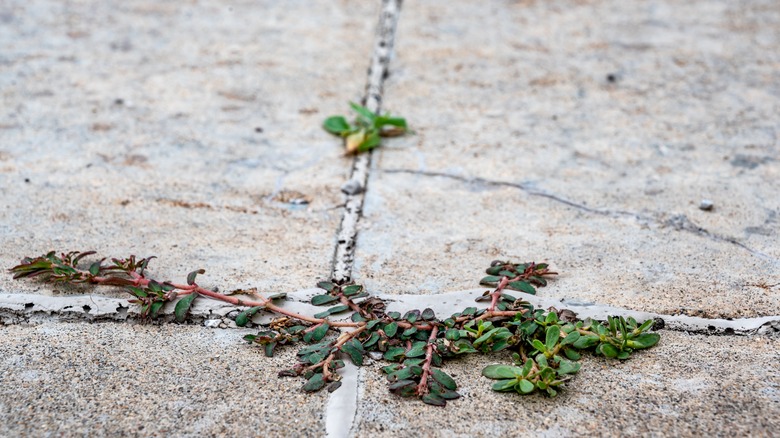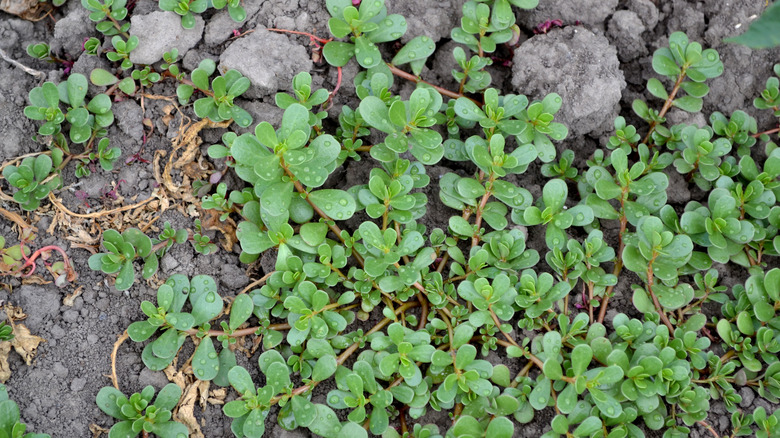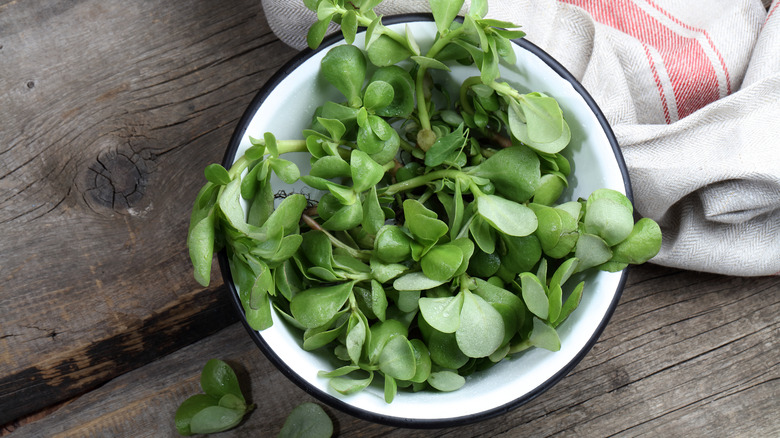Is That Pesky Weed That Refuses To Die Actually A Super Plant?
Everyone who has a yard or a driveway has most certainly attempted to tame purslane (Portulaca oleracea). Since it's one of the most annoying weeds around, we're sure the fight has often felt futile. It's the one with thick red stems and tiny green leaves that pops up through the cracks in your pavement and refuses to die no matter how many different ways you try to kill it; the one you can't stop from growing on your lawn ... yes, that one. At some point, you've probably found yourself desperately hacking away at it, yanking it out, and spraying it with an array of chemicals, meaning you know just how hard it is to get rid of.
The reasons purslane is such a tricky weed are diverse. Per the University of Illinois Extension, it can thrive in basically any conditions you give it. Nutrient-dense garden bed? Great. A dry, cracked, nutrient-devoid pile of dirt? No problem either. Purslane also self-seeds and can regenerate itself into a new plant from the tiniest piece of stem left behind on the ground.
If you've been as perplexed by this weed as we have, then it's time to get ready for a shocker. According to the Good News Network, one of the latest breaking bits of news in the botanical world is that scientists at Yale have come to believe the weed is actually a super plant, holding much-needed information on how to help the world's ongoing hunger crisis.
What did scientists discover about purslane?
Over millions of years, plants have developed two different systems that aid in photosynthesis when environmental conditions swing to an extreme. For excessive temperatures, a process called C4 photosynthesis kicks into drive to keep food crops like sugarcane and corn going strong. In a different way, the survival mechanism that allows cacti and succulents to thrive in the desert is called CAM photosynthesis, per the Henry Shaw Cactus and Succulent Society. Until now, it had been believed that it was an either/or situation. There were C4 plants and there were CAM plants, while others had no such mechanisms in place and would simply die off when conditions worsened.
The Good News Network reports, however, that purslane has somehow developed both systems, which operate simultaneously within the same cells. This huge finding changes the way scientists think about metabolic pathways, and it explains how the plant is able to not only persevere during intense periods of drought but also remain productive through it. So, while many of us have been trying to figure out how to rid our lives of this pesky weed, professors and scientists at Yale University have been trying to figure out how to harness its metabolic anomaly and reproduce it in other plants. If they are successful, it could mean engineering food crops that can also sustain themselves and flourish through severe drought and, in turn, feed a lot of people who are in dire need of sustenance.
Is purslane good for anything else?
If you can believe it, purslane, also called portulaca, is good for a few more things as well. Some people have enjoyed successfully growing portulaca plants in hanging baskets and gardens; of course, they tend to prefer the prettier Portulaca grandiflora variety for its abundance of brightly colored flowers. Chefs worldwide have also long understood the culinary uses for purslane leaves (via The Chicago Tribune).
Furthermore, it's highly nutritious. A 2014 study published in Scientific World Journal says purslane boasts more essential omega-3 fatty acids than any other leafy green, specifically in the form of alpha-linolenic. It also beat out spinach seven times over with more alpha-tocopherol, an E vitamin that prevents blood clots, reduces free radical cell damage, and gives the immune system a boost before it's done for the day. The folks at Raising Happy Chickens note that purslane is an excellent addition to chicken feed because it provides nutrients to the birds, which then get passed on to humans through their eggs.
Is it possible that this extremely annoying weed that just won't go away is actually a beautiful and beneficial plant we should figure out how to harness and respect? We're starting to think so.


